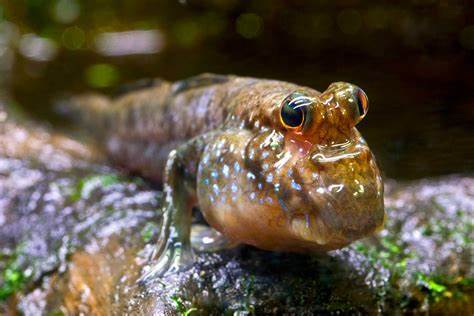My Store
MUD SKIPPER
MUD SKIPPER
Couldn't load pickup availability
Mudskipper – Amphibious Oddball That Walks, Climbs, and Breathes Air
The Mudskipper is one of the most fascinating and truly unique creatures in the aquarium world. Known for its amphibious nature, ability to walk on land, and bulging, expressive eyes, the mudskipper bridges the gap between land and water—literally. Found in mangrove swamps and brackish tidal flats, these fish spend more time out of the water than in, using their strong pectoral fins to "walk" and interact with their environment.
Whether you're building a paludarium, brackish habitat, or a display that demands something extraordinary, the mudskipper offers endless entertainment and educational value. It’s playful, territorial, and always curious, making it the perfect oddball addition for adventurous aquarists.
🐟 Species Profile:
-
Common Name: Mudskipper
-
Scientific Family: Oxudercinae
-
Adult Size: 4–8 inches (varies by species)
-
Temperament: Semi-aggressive and territorial
-
Minimum Enclosure: 20+ gallon paludarium or shallow brackish tank
-
Water Parameters: 75–82°F | pH 7.5–8.5 | Brackish water (SG 1.005–1.015)
-
Diet: Carnivore – eats live/frozen worms, crickets, insects, and sinking pellets
🛠️ Tank Setup & Compatibility:
Mudskippers thrive in:
-
Paludariums or shallow tanks with both land and water zones
-
Brackish water with a secure top (they will climb and jump)
-
Sand or mud substrate with rocks, driftwood, and basking areas
Behavior:
-
🦎 Walks, climbs, and perches above water for hours
-
🫁 Breathes air using a modified gill system – requires surface access
-
🧠 Extremely curious and interactive – will “watch” you and explore constantly
-
⚔️ Can be territorial – best kept singly or in larger enclosures with clear land divisions
Tank Mates:
-
Best kept in species-only setups or with other brackish oddballs that don’t compete for land
-
Avoid fully aquatic fish or anything that may nip or stress them
🛒 Why Buy Mudskippers from RobsAquatics.com?
Each Mudskipper is:
-
✅ Acclimated to brackish water and land interaction
-
✅ Health-inspected and feeding on a varied carnivorous diet
-
✅ Shipped live with our Live Arrival Guarantee
-
✅ Perfect for paludarium enthusiasts, oddball collectors, and interactive setups
📦 Bring the shoreline to your aquarium room with the Mudskipper—a walking, climbing, air-breathing wonder available now at RobsAquatics.com.
Share


